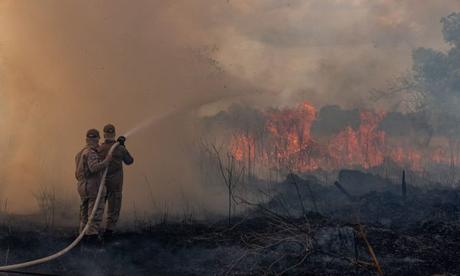As the fire disaster in the Amazon rainforest in Brazil has slowly pulled the global attention, it has also revealed an even higher number of fires currently burning in central Africa.
NASA’s Fire Information for Resource Management System disclosed 3,395 fires burning in the Democratic Republic of the Congo and minimum 6,902 fires in Angola.

Brazil’s fires are at 2,127 as per the same data.
This year, the massive surge in fires in the Amazon has become a global concern. The rainforest is the earth’s most biodiverse land area that stores carbon in considerable amounts in the present complex ecosystem. Hence it is essential to conserve the rainforest to limit the impacts of global heating.
The extent of the fires in Africa affecting forested areas is, however, unclear. For thousands of years, fires have been a regular part of farming techniques in agricultural areas.
Farmers set fires to crop fields to burn off the leftover scrub plants and grasses. This burning is helpful to maintain fertile soils that are good for farming.
However, it is a matter of growing concern that the lack of traditional grasslands is driving the clearing of forests by burning in parts of Africa.
Scientists have warned that the rapid rate of deforestation in the Amazon put it at the high risk of reaching a tipping point at which vast swathes of the rainforest would degrade into dry savannah areas.
“You’d have extensive parts of the southern and eastern Amazon and parts of the central converting to savannah, and maybe to even drier conditions,” Professor Thomas Lovejoy of George Mason University told The Independent.
Agricultural activity has caused most of the forest fires in Brazil due to stubble burning after harvest, using illegal slash and burn clearing techniques by the landowners to create land for crops or rearing beef, or to raise the value of the land by logging.
Global awareness of the illegal deforestation problem is increasing, still greater tropical rainforest areas are being lost than ever, and in this century across the world more tree cover was lost in the year 2016 and 2017 than in any other period.
The rate of deforestation in the Brazilian Amazon covers 870 square miles in July, which is nearly five football pitches every minute of the entire month.
Carlos Nobre, a senior researcher at the University of São Paulo and Professor Lovejoy’s colleague, told The Guardian this year deforestation was on course to rise by 20 to 30 percent and was “very likely” to cross 10,000 sq km for the first time in over a decade.
According to Richard Black, the director of the Energy and Climate Intelligence Unit, whether the fires in Africa represented similar problems like those affecting the Amazon recently, was difficult to determine.
He told The Independent: “Clearly both in the Amazon and in the Congo, burning by small scale farmers, is a way of life, it does happen. What’s different is the increase in the Amazon this year over last year – almost a doubling in the number of fires.”
“Bolsonaro seems to be encouraging this, but I haven’t seen any evidence of this in any of [the African] countries, is a key difference I think.”
Emmanuel Macron, who exchanged rhetorical blows with Brazilian president Jair Bolsonaro, described the Amazon as the “lungs of the world,” and tweeted “our house is burning” in the last week.
The G7 countries pledged $20m (£16m) to help Brazil to fight the fires, following a summit in France.
On Tuesday, however, Brazil made an announcement rejecting the offer.
Mr Macron later drew attention to the fires in sub-Saharan Africa and said: “We are considering the possibility of launching an initiative similar to the one we just announced for the Amazon.”
Mr Black told The Independent: “I think there’s an utter naivety in the whole idea.
“With the Bolsonaro situation, it’s clear one of the reasons why he’s keen to see the Amazon exploited is because he doesn’t like the international attempts [at intervention].
“There has been, for a number of years now, a big operation to put money into the Amazon. What Bolsonaro shows is that programmes like this can only really endure if there is genuinely political will in the recipient country to keep these things going. Because there’s no point in paying to protect a forest for five years.
“I’m not remotely surprised he rejected [the $20m]. It absolutely could have been predicted because his political philosophy is very much: ‘we’re going to decide, Brazil’s going to decide what happens to this,’ so I’m not surprised he rejected it at all.
“Also the sums of money are piffling if you’re talking about serious protection efforts.”
The data of NASA also reveals that fires are affecting parts of the Amazon outside Brazil, spreading into eight other South American countries, including Bolivia. Across Indonesia, there are also thousands of wildfires burning.
“There are the three great tropical forests. The Amazon, the Congo and Indonesia and Borneo. They’re all massively important, and in all of them over the last 20 years we’re seen really destructive forest fires.”

